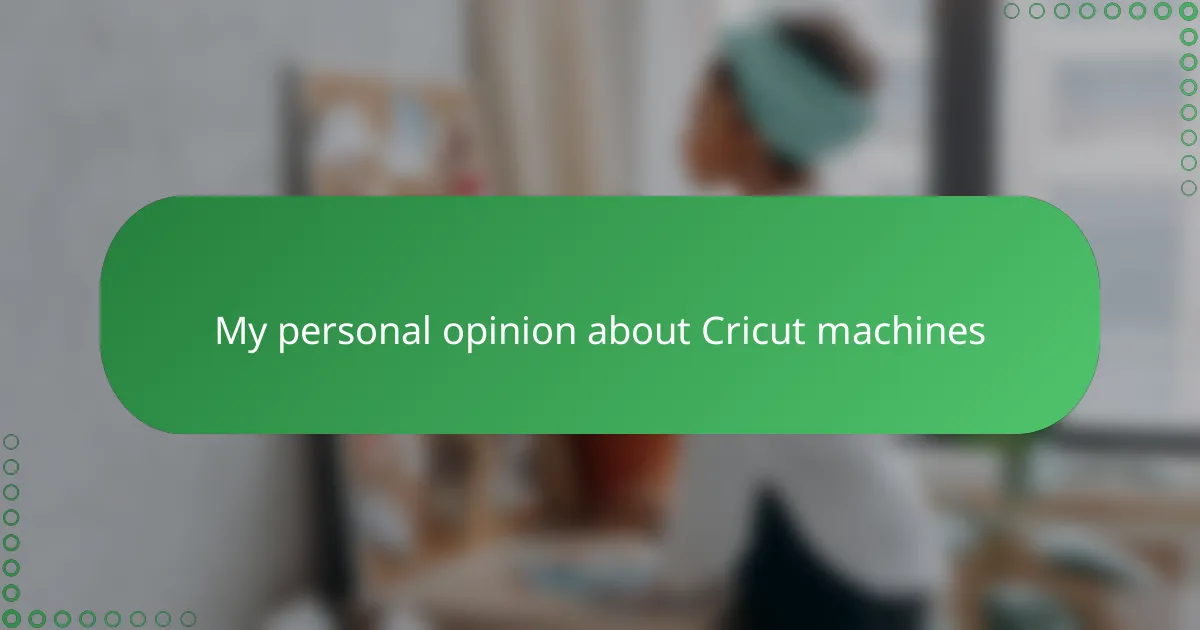Key takeaways
- Cricut machines enhance precision and creativity in paper crafting, allowing for intricate designs with ease.
- Investing in the right Cricut model depends on crafting habits, project types, and available space.
- Effective tips include testing cuts on scrap paper, maintaining blade sharpness, and organizing materials for smoother crafting sessions.
- Cricut serves as a creative partner, elevating handmade crafts while preserving the personal touch of the maker.
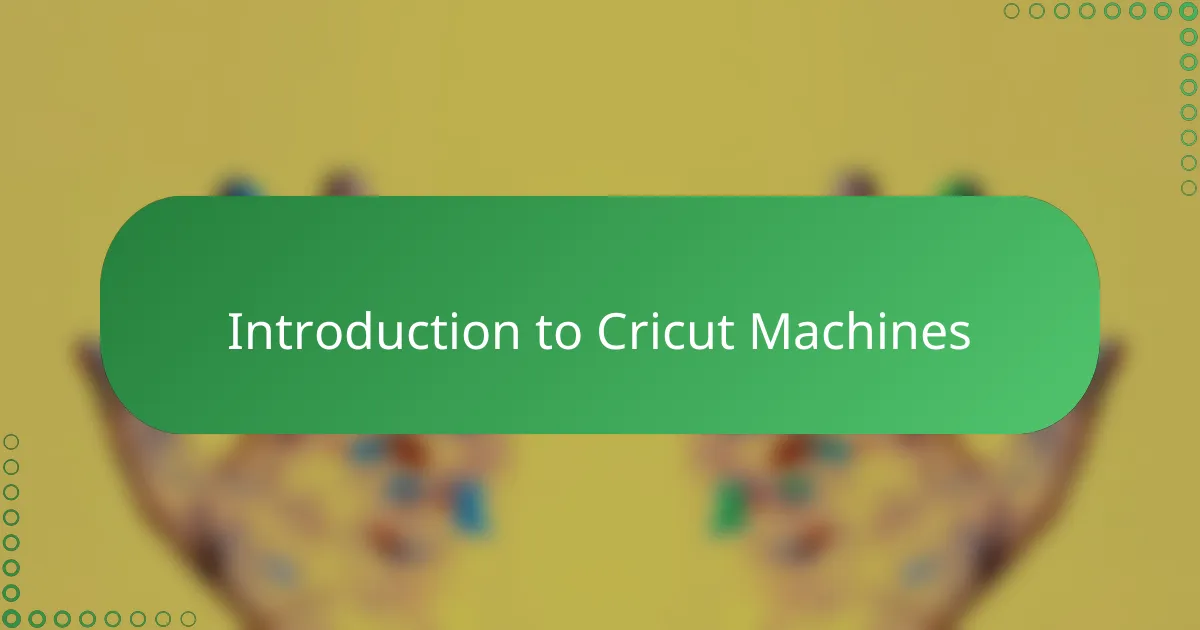
Introduction to Cricut Machines
Cricut machines are essentially electronic cutting tools designed for crafters like me who love precision and creativity. When I first tried one, I was amazed at how effortlessly it cut through intricate designs on paper, vinyl, and other materials. Have you ever struggled to cut tiny shapes by hand? That’s exactly where Cricut shines.
What makes Cricut stand out is its user-friendly software combined with powerful hardware. I remember feeling a bit intimidated at first, but soon found myself playing around with various fonts, shapes, and patterns, unlocking so many creative possibilities. It’s like having a crafty assistant that’s always ready to help bring your ideas to life.
In my experience, owning a Cricut has transformed simple paper crafts into something much more polished and professional. It’s not just about convenience—there’s a genuine joy in watching a machine bring your handmade vision into reality with such precision. Could a machine ever replace the personal touch? Maybe not, but it certainly enhances it in ways I hadn’t imagined before.
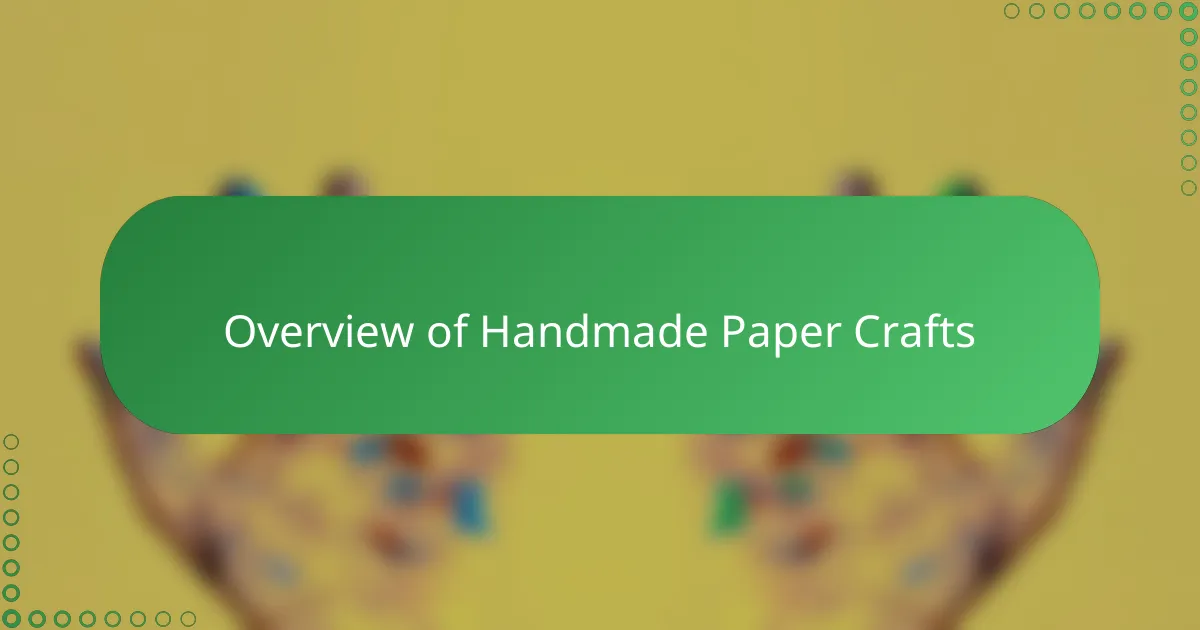
Overview of Handmade Paper Crafts
Handmade paper crafts have always held a special place in my heart. There’s something incredibly satisfying about feeling the texture of quality paper, watching delicate folds come together, and seeing each piece transform under your hands. Have you ever noticed how paper can carry so much personality, even before any decorations are added?
What fascinates me most is the endless variety of techniques—from embossing and layering to quilling and stamping—that turn simple sheets into stunning art. Each method offers a unique way to express creativity and tells a little story about the maker’s style and mood at that moment. It’s this personal connection that makes handmade paper crafts so captivating to me.
While handmade paper crafts often require patience and precision, it’s the imperfections that make each creation truly one-of-a-kind. Don’t you think there’s a beauty in those slight irregularities, the subtle differences that machines can’t replicate? To me, those nuances are what give paper crafts their soul.
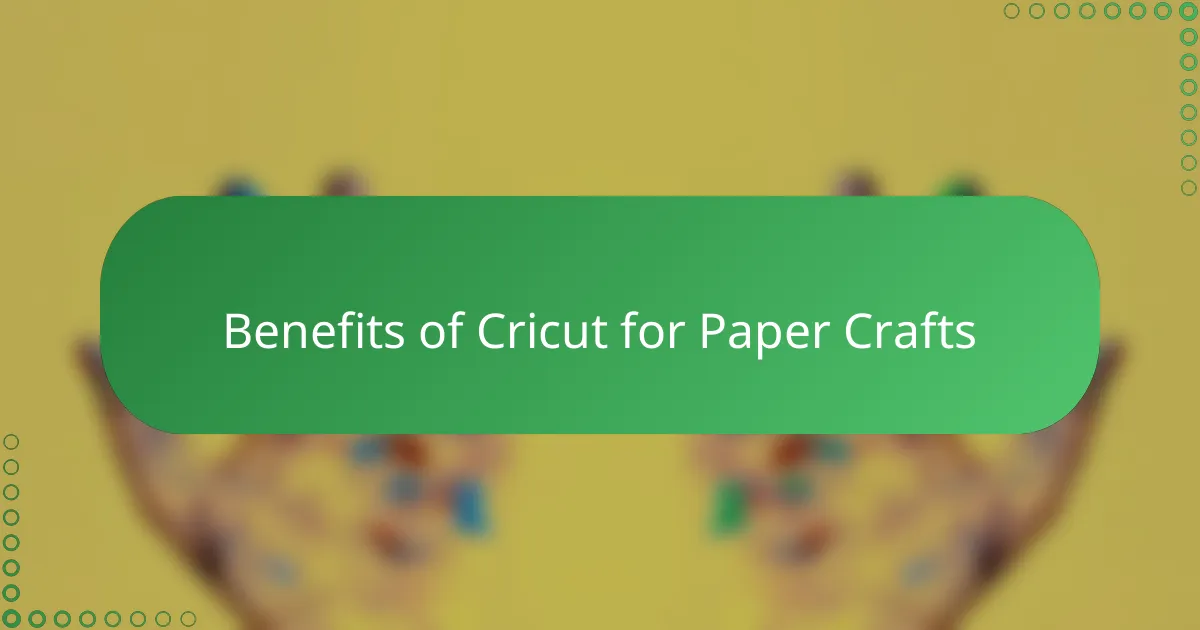
Benefits of Cricut for Paper Crafts
One of the biggest benefits I’ve found with using a Cricut for paper crafts is the incredible precision it offers. When cutting delicate patterns or tiny shapes, my hands sometimes just can’t match the machine’s accuracy. Have you ever felt frustrated when a detailed cut gets ruined because of a shaky hand? That’s where the Cricut truly feels like a game-changer.
Another thing I appreciate is the time it saves me. What used to take hours of careful cutting now happens in just minutes. This means I can focus more on designing and assembling rather than spending so much time on the cutting itself. Isn’t it wonderful when technology helps you spend more time doing what you love?
Plus, the versatility of the Cricut really impresses me. It’s not just about cutting straight lines; it effortlessly navigates complex curves, intricate patterns, and even lettering. This expands the creative possibilities I didn’t have before and encourages me to try new projects I’d previously avoided. Don’t you love it when a tool pushes you to get more creative?
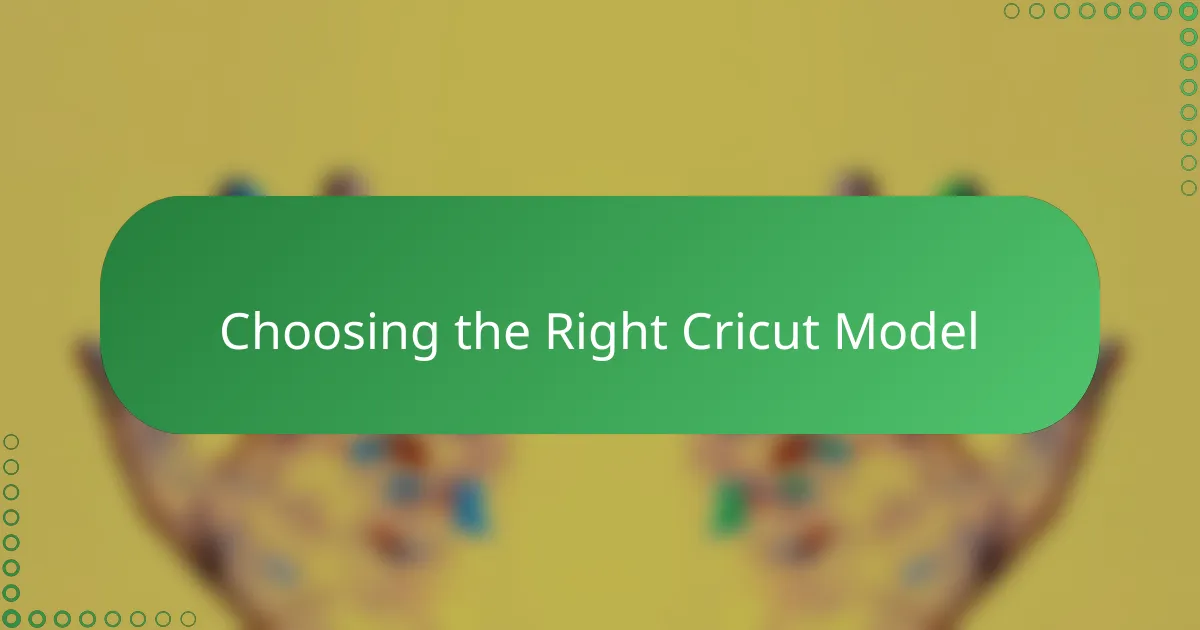
Choosing the Right Cricut Model
Choosing the right Cricut model can feel a bit overwhelming at first—trust me, I’ve been there. I remember agonizing over which one to pick, trying to balance budget, size, and the types of projects I wanted to create. Have you ever wondered if you really need all the bells and whistles, or if a basic model will do the job just fine?
For me, understanding my crafting habits made all the difference. If you mostly work with paper and occasional vinyl, a model like the Cricut Explore Air 2 is a fantastic middle ground—powerful without being too complex. But if you crave cutting fabric or want a faster machine for bulk projects, stepping up to the Maker can feel like investing in a true creative partner.
It’s also important to think about space and portability. I found that a smaller machine fit perfectly on my craft table and was easy to store when I needed the surface cleared. Do you have a dedicated craft space, or do you prefer something you can tuck away? That practical consideration helped me narrow down my choices more than any feature list ever could.

Personal Experience with Cricut Machines
When I first unpacked my Cricut machine, I was both excited and a little uncertain. Would it really live up to the hype? From my very first cut, I felt a rush of satisfaction—the machine handled delicate paper like a pro, and I realized this tool was going to change how I approach every project.
There was this one time I attempted a detailed floral design that I’d always avoided because cutting those tiny petals by hand was a nightmare. Seeing it come out perfectly on the first try was almost magical. Have you ever had that moment when a new tool suddenly sparks your confidence? That’s exactly how I felt.
Of course, the learning curve mattered too. Getting used to the software and figuring out how to load materials correctly took some patience. But once I nailed those basics, the creative freedom I found made every challenge worth it. Isn’t it amazing when technology doesn’t just do the work but actually inspires you?
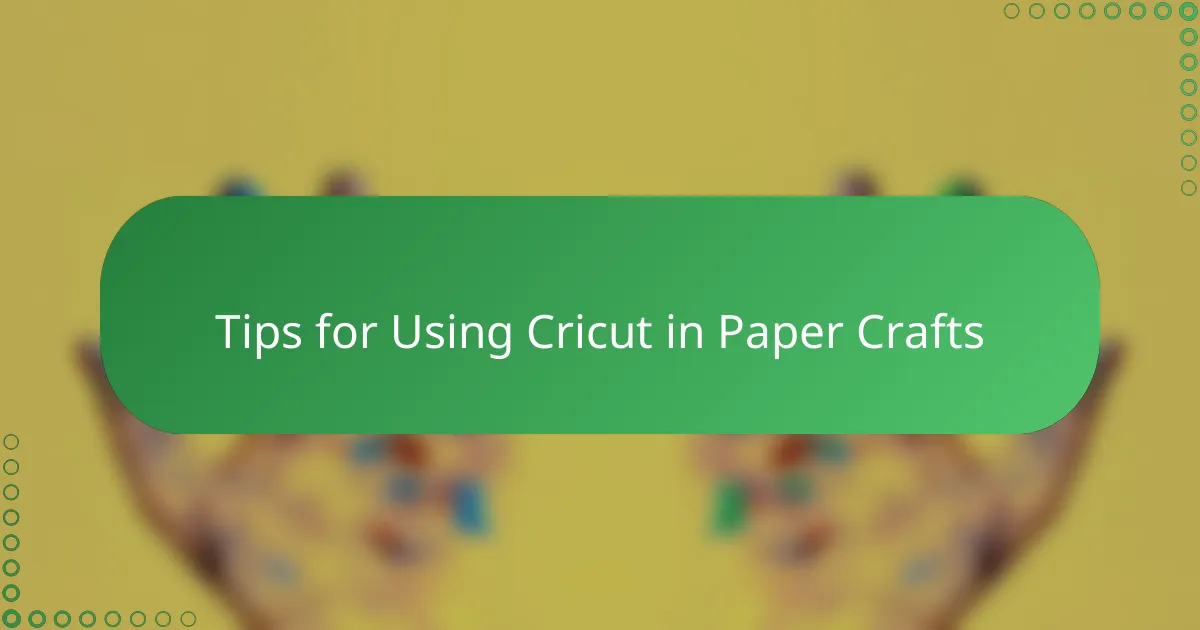
Tips for Using Cricut in Paper Crafts
One tip I’ve found invaluable is to always do a test cut on scrap paper first. It saved me more than once from ruining my good cardstock, especially when I was trying out new designs or adjusting the pressure settings. Have you ever felt that sting when a precious piece goes wrong? That quick test cut really eases the anxiety.
I also recommend keeping your blade sharp and clean. I learned this the hard way—once, my cuts started tearing and I couldn’t figure out why until I checked the blade. It’s like using a dull pencil; the results just aren’t crisp. How often do you pay attention to your tools’ condition? For me, this simple habit made such a difference in the final look of my crafts.
Another tip I swear by is organizing your materials before starting a project. Having all your different paper types, cutting mats, and tools within arm’s reach keeps the creative flow smooth and frustration low. Isn’t it amazing how a little preparation can turn a chaotic craft session into pure joy? Trust me, it’s a game-changer.
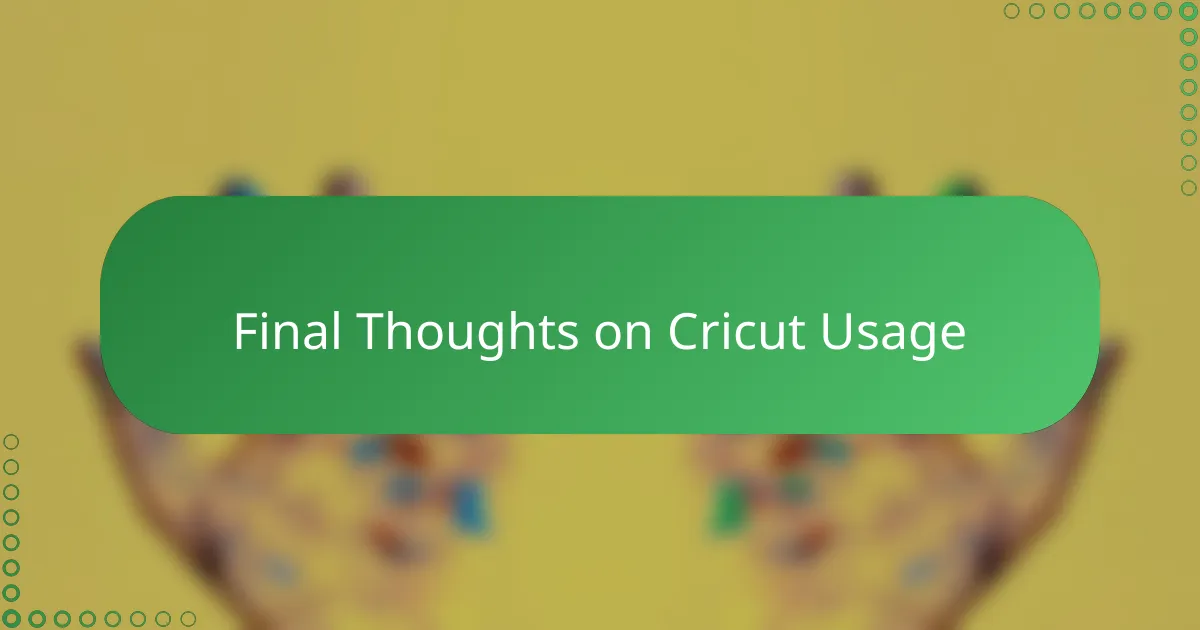
Final Thoughts on Cricut Usage
Using a Cricut has, without a doubt, elevated my paper crafting in ways I hadn’t imagined. I sometimes catch myself marveling at how a machine can bring such crisp detail to my work—details that once seemed too fiddly or time-consuming by hand. Doesn’t it feel a bit like having an extra set of skilled hands when you need it most?
That said, I’ve learned that a Cricut isn’t a magic wand; it still requires patience, especially when learning the software or troubleshooting cuts. I remember a few frustrating moments when settings needed tweaking, but each small victory made me feel more connected to my crafting process. Have you ever experienced that mix of challenge and triumph with a new tool?
In the end, the Cricut feels less like a replacement for handmade charm and more like a creative partner that expands what’s possible. It’s brought a fresh spark to my projects, inviting experimentation and confidence I didn’t have before. Can a machine capture the soul of handmade crafts? Maybe not entirely—but it surely deepens the joy of making.
